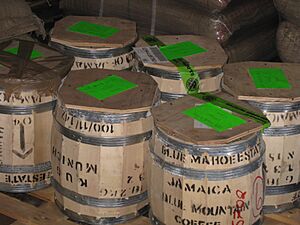Coffee production in Jamaica facts for kids
Coffee production in Jamaica started way back in 1728. That's when Governor Sir Nicholas Lawes brought coffee plants to the island. He planted them near Castleton, which is north of Kingston.
One very special type of coffee grown here is Jamaican Blue Mountain Coffee. It comes from the Blue Mountains area. This region has the perfect weather and land for growing coffee. This coffee is famous for its amazing smell and sweet taste. Most of the coffee grown in Jamaica is sold to other countries.
Where Does Jamaican Coffee Grow?
Most of the coffee plants in Jamaica are a type called Coffea arabica Typica. This kind makes up about 70% of all the coffee grown. Other types, like caturra and geisha, are also grown.
The Jamaican Blue Mountain Coffee is known for being very high quality. It grows in the Blue Mountains region. This special coffee is mostly sold to other countries.
Coffee plants in Jamaica grow at high places, from about 15–1,603 metres (49–5,259 ft) above sea level. They get a lot of rain, from 125 centimetres (49 in) to over 700 centimetres (280 in) each year. Farmers use special ways to grow coffee so it produces a lot and tastes great.
Who Looks After Coffee Production?
The Ministry of Agriculture in Jamaica helps manage everything about coffee. The Jamaica Agricultural Commodities Authority (JACRA) also plays a big role. They make sure coffee is grown and sold properly.
There's a special rule called the Coffee Industry Regulation Act. This law says which coffee can be called "Blue Mountain Coffee." It also protects the "Blue Mountain" name. Only coffee approved by JACRA can use this famous name. Generally, coffee from the parishes of Saint Andrew, Saint Thomas, Portland, and Saint Mary can be called Blue Mountain coffee.
How Much Coffee Does Jamaica Make?

In 2013, Jamaica produced about 6,984 tons of coffee. This was a small part of the world's coffee, about 0.1%. The coffee was grown on about 8,000 hectares (20,000 acres) of land.
Coffee is a very important product that Jamaica sells to other countries. Growing, processing, and selling coffee gives many jobs to people in both the countryside and cities. Jamaica often wants to sell more coffee than it can produce.
More than 80% of the special Jamaican Blue Mountain Coffee goes to Japan. In 2005, there was less coffee to sell because a big storm called Hurricane Ivan damaged the crops in late 2004.


